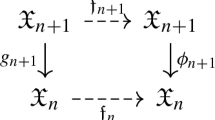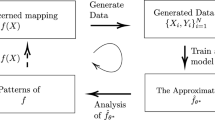Abstract
In this paper, we show the abundance theorem for log canonical surfaces over fields of positive characteristic.
Similar content being viewed by others
References
Birkar, C.: On existence of log minimal models II. J. Reine Angew. Math. 658, 99–113 (2011)
Birkar, C.: The augmented base locus of real divisors over arbitrary fields. Math. Ann. 368(3–4), 905–921 (2017)
Birkar, C., Chen, Y., Zhang, L.: Iitaka’s \(C_{n, m}\) conjecture for \(3\)-folds over finite fields. Nagoya Math. J. 229, 21–51 (2018)
Fujino, O.: Minimal model theory for log surfaces. Publ. Res. Inst. Math. Sci. 48(2), 339–371 (2012)
Fujino, O.: Foundation of the Minimal Model Program. MSJ Memoirs, vol. 35. Mathematical Society of Japan, Tokyo (2017)
Fujino, O., Tanaka, H.: On log surfaces. Proc. Jpn. Acad. Ser. A Math. Sci. 88(8), 109–114 (2012)
Fujita, T.: Semipositive line bundles. J. Fac. Sci. Univ. Tokyo Sect. IA Math. 30(2), 353–378 (1983)
Fujita, T.: Fractionally logarithmic canonical rings of algebraic surfaces. J. Fac. Sci. Univ. Tokyo Sect. IA Math. 30(3), 685–696 (1984)
Keel, S.: Basepoint freeness for nef and big linebundles in positive characteristic. Ann. Math. 149, 253–286 (1999)
Kollár, J.: Singularities of the Minimal Model Program. Cambridge Tracts in Mathematics, vol. 200 (2013)
Kollár, J., Mori, S.: Birational Geometry of Algebraic Varieties, Cambrigde Tracts in Mathematics, Vol. 134 (1998)
Maddock, Z.: Regular del Pezzo surfaces with irregularity. J. Algebra Geom. 25(3), 401–429 (2016)
Maşek, V.: Kodaira-Iitaka and numerical dimensions of algebraic surfaces over the algebraic closure of a finite field. Rev. Roumaine Math. Pure. Appl. 38(7–8), 679–685 (1993)
Seidenberg, A.: The hyperplane sections of normal varieties. Trans. Am. Math. Soc. 69, 357–386 (1950)
Schröer, S.: Weak del Pezzo surfaces with irregularity. Tohoku Math. J. 59, 293–322 (2007)
Tanaka, H.: Minimal models and abundance for positive characteristic log surfaces. Nagoya Math. J. 216, 1–70 (2014)
Tanaka, H.: Semiample perturbations for log canonical varieties over an F-finite field containing an infinite perfect field. Int. J. Math. 28(5), 1750030, 13 (2017)
Tanaka, H.: Behavior of canonical divisors under purely inseparable base changes. J. Reine Angew. Math. 744, 237–264 (2018)
Tanaka, H.: Minimal model program for excellent surfaces. Ann. Inst. Fourier (Grenoble) 68(1), 345–376 (2018)
Acknowledgements
Part of this work was done whilst the author visited National Taiwan University in December 2013 with the support of the National Center for Theoretical Sciences. He would like to thank Professor Jungkai Alfred Chen for his generous hospitality. The author would like to thank Professors Caucher Birkar, Yoshinori Gongyo, Paolo Cascini, János Kollár, Mircea Mustaţă, Chenyang Xu for very useful comments and discussions. The author also thanks the referee for reading the manuscript carefully and for suggesting several improvements. This work was partially supported by JSPS KAKENHI (No. 24224001) and EPSRC.
Author information
Authors and Affiliations
Corresponding author
Additional information
Publisher's Note
Springer Nature remains neutral with regard to jurisdictional claims in published maps and institutional affiliations.
Appendix A. Shokurov polytopes in convex geometry
Appendix A. Shokurov polytopes in convex geometry
In this section, we summarise some results of Shokurov polytopes in a setting of convex geometry. We fix the following notation.
Notation A.1
Let M and N be torsion free \(\mathbb {Z}\)-modules and let
be a \(\mathbb {Z}\)-bilinear homomorphism. For \(D\in M\) and \(C \in N\), we write
by abuse of notation. Assume that \(\dim _{\mathbb {R}}M_{\mathbb {R}}<\infty \), i.e. M is a free \(\mathbb {Z}\)-module of finite rank. Fix a rational polytope \(\mathcal {L} \subset M_{\mathbb {R}}\). Fix an \(\mathbb {R}\)-linear basis of \(M_{\mathbb {R}}\) and we denote the sup norm with respect to this basis by \(||\bullet ||\).
Lemma A.2
We use Notation A.1. Fix \(K \in M_{\mathbb {Q}}\), \(\Delta \in \mathcal {L}\), and \(\rho \in \mathbb {R}_{>0}\). Then, there exist positive real numbers \(\epsilon , \delta >0\), depending on K, \(\Delta \), and \(\rho \), which satisfy the following properties.
- (1)
For every \(C \in N\) such that \(-(K+B)\cdot C \le \rho \) for all \(B\in \mathcal {L}\), if \((K+\Delta )\cdot C>0\), then \((K+\Delta )\cdot C>\epsilon \).
- (2)
If \(C\in N\) and \(B_0\in \mathcal {L}\) satisfy \(||B_0-\Delta ||<\delta \), \((K+B_0)\cdot C\le 0\), and \(-(K+B)\cdot C \le \rho \) for all \(B\in \mathcal {L}\), then \((K+\Delta )\cdot C\le 0\).
Proof
The assertions follow from the same proof as in [1, Proposition 3.2(1)] or [5, Theorem 4.7.2(1)]. The assertion (2) follows from the same proof as in [5, Theorem 4.7.2(2)] (although the statement of [5, Theorem 4.7.2(2)] is the same as the one of [1, Proposition 3.2(2)], [5, Theorem 4.7.2(2)] fixes minor errors appearing in [1, Proposition 3.2(2)]). \(\square \)
Proposition A.3
We use Notation A.1. Let \(K \in M_{\mathbb {Q}}\) and \(\rho \in \mathbb {R}_{>0}\). Fix a subset \(\{C_t\}_{t\in T} \subset N\) such that
for every \(t \in T\) and every \(B\in \mathcal {L}\). For any subset \(T' \subset T\), we define
Then there exists a finite subset \(S \subset T\) such that
In particular \(\mathcal {N}_{T}\) is a rational polytope.
Proof
We can apply the same argument as in [1, Proposition 3.2(3)] by using Lemma A.2 instead of [1, Proposition 3.2(1)(2)]. \(\square \)
Rights and permissions
About this article
Cite this article
Tanaka, H. Abundance theorem for surfaces over imperfect fields. Math. Z. 295, 595–622 (2020). https://doi.org/10.1007/s00209-019-02345-2
Received:
Accepted:
Published:
Issue Date:
DOI: https://doi.org/10.1007/s00209-019-02345-2




